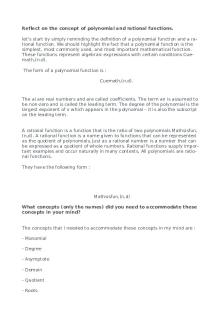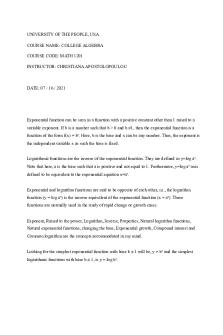MATH 1201 (Exponential and Logarithmic Functions) College Algebra Learning Journal Unit 5 PDF

| Title | MATH 1201 (Exponential and Logarithmic Functions) College Algebra Learning Journal Unit 5 |
|---|---|
| Course | College Algebra |
| Institution | University of the People |
| Pages | 3 |
| File Size | 54.3 KB |
| File Type | |
| Total Downloads | 101 |
| Total Views | 135 |
Summary
Exponential and Logarithmic Functions ( MATH 1201 College Algebra Learning Journal Unit 5) Note of Exponential and Logarithmic functions....
Description
UNIVERSITY OF THE PEOPLE, USA. COURSE NAME: COLLEGE ALGEBRA COURSE CODE: MATH 1201 INSTRUCTOR: CHRISTIANA APOSTOLOPOULOU
DATE: 07 / 16 / 2021
Exponential function can be seen as a function with a positive constant other than 1 raised to a variable exponent. If b is a number such that b > 0 and b ≠1, then the exponential function is a function of the form f(x) = bx. Here, b is the base and x can be any number. Thus, the exponent is the independent variable x as such the base is fixed. Logarithmic functions are the inverse of the exponential function. They are defined as y=log ax. Note that here, a is the base such that a is positive and not equal to 1. Furthermore, y=log ax axis defined to be equivalent to the exponential equation x=ay.
Exponential and logarithm functions are said to be opposite of each other, i.e., the logarithm function (y = log ax) is the inverse equivalent of the exponential function (x = ay). These functions are normally used in the study of rapid change or growth cases.
Exponent, Raised to the power, Logarithm, Inverse, Properties, Natural logarithm functions, Natural exponential functions, changing the base, Exponential growth, Compound interest and Common logarithm are the concepts accommodated in my mind. Looking for the simplest exponential function with base b ≠ 1 will be, y = bx and the simplest logarithmic functions with base b ≠ 1, is y = log bx.
Exponential and logarithmic functions are used in modeling growth patterns. These functions can be identified in numerous real-world applications when it comes to modeling and interpreting data. The ongoing pandemic, COVID-19 is a like-factor, the rate of spread and factors mounting to the monitoring the growth and decay of the virus is a study centered on exponential and logarithmic functions.
The useful strategy to get the graph of exponential or logarithmic functions according to Abramson, J. (2017). “Given an exponential function of the form f (x) = b x, graph the function.
Create a table of points.
Plot at least 3 point from the table, including the y-intercept (0, 1).
Draw a smooth curve through the points.
State the domain, (−∞, ∞), the range, (0, ∞), and the horizontal asymptote, y = 0.” (p. 480.)
“Given a logarithmic function, identify the domain.
Set up an inequality showing the argument greater than zero.
Solve for x.
Write the domain in interval notation.” (p. 500.)
Desmos online graphing calculator is another strategy that makes graphing simple and easy.
Reference
Abramson, J. (2017). Algebra and trigonometry. OpenStax, TX: Rice University. Retrieved from https://openstax.org/details/books/algebra-and-trigonometry...
Similar Free PDFs

journal unit 3 - college algebra
- 3 Pages

Learning Journal Unit 5
- 2 Pages

Unit 5 Learning Journal
- 2 Pages

Learning Journal Unit 5
- 2 Pages
Popular Institutions
- Tinajero National High School - Annex
- Politeknik Caltex Riau
- Yokohama City University
- SGT University
- University of Al-Qadisiyah
- Divine Word College of Vigan
- Techniek College Rotterdam
- Universidade de Santiago
- Universiti Teknologi MARA Cawangan Johor Kampus Pasir Gudang
- Poltekkes Kemenkes Yogyakarta
- Baguio City National High School
- Colegio san marcos
- preparatoria uno
- Centro de Bachillerato Tecnológico Industrial y de Servicios No. 107
- Dalian Maritime University
- Quang Trung Secondary School
- Colegio Tecnológico en Informática
- Corporación Regional de Educación Superior
- Grupo CEDVA
- Dar Al Uloom University
- Centro de Estudios Preuniversitarios de la Universidad Nacional de Ingeniería
- 上智大学
- Aakash International School, Nuna Majara
- San Felipe Neri Catholic School
- Kang Chiao International School - New Taipei City
- Misamis Occidental National High School
- Institución Educativa Escuela Normal Juan Ladrilleros
- Kolehiyo ng Pantukan
- Batanes State College
- Instituto Continental
- Sekolah Menengah Kejuruan Kesehatan Kaltara (Tarakan)
- Colegio de La Inmaculada Concepcion - Cebu











